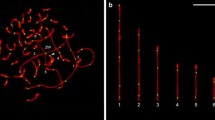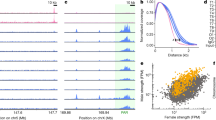Abstract
Thewm7 haplotype of the major histocompatibility complex (MHC), derived from the Japanese wild mouseMus musculus molossinus, enhances recombination specific to female meiosis in theK/A β interval of the MHC. We have mapped crossover points of fifteen independent recombinants from genetic crosses of thewm7 and laboratory haplotypes. Most of them were confined to a short segment of approximately 1 kilobase (kb) of DNA between theA β3 andA β2 genes, indicating the presence of a female-specific recombinational hotspot. Its location overlaps with a sex-independent hotspot previously identified in theMus musculus castaneus CAS3 haplotype. We have cloned and sequenced DNA fragments surrounding the hotspot from thewm7 haplotype and the corresponding regions from the hotspot-negative B10.A and C57BL/10 strains. There is no significant difference between the sequences of these three strains, or between these and the published sequences of the CAS3 and C57BL/6 strains. However, a comparison of this Aβ3/Aβ2 hotspot with a previously characterized hotspot in theEβ gene revealed that they have a very similar molecular organization. Each hotspot consists of two elements, the consensus sequence of the mouse middle repetitive MT family and the tetrameric repeated sequences, which are separated by 1 kb of DNA.
Similar content being viewed by others
References
Begovich, A. B. and Jones, P. P.: Free Ia Eα chain expression in the E sup+infα : E sup−infβ recombinant strain A.TFR5.Immunogenetics 22: 523–532, 1985
Chakrabarti, S. and Seidman, M. M.: Intramolecular recombination between transfected repeated sequences in mammalian cells is non-conservative.Mol Cell Biol 6: 2529–2526, 1986
Davisson, M. T. and Roderick, T. H.: Recombination percentages.In M. C. Green (ed.):Genetic Variants and Strains of the Laboratory Mouse, pp. 283–313, Fisher, Stuttgart, 1981
Donis-Keller, H., Green, P., Helms, C., Cartinhour, S., Weiffenbach, B., Stephens, K., Keith, T. P., Bowden, D. W., Smith, D. R., Lander, E. C., Botstein, D., Akots, G., Rediker, K. S., Gravius, T., Brown, V. A., Rising, M. B., Parker, C., Powers, J. A., Watt, D. E., Kauffman, E. R., Briker, A., Phipps, P., Muller-Kahle, H., Fulton, T. R., Ng, S., Schumm, J. W., Braman, J. C., Knowlton, R. G., Barker, D. F., Crooks, S. M., Lincoln, S. E., Daly, M. J., and Abrahamson, J.: A genetic linkage map of the human genome.Cell 51: 319–337, 1987
Edelman, W., Kroger, B., Goller, M., and Horak, I.: A recombination hotspot in the LTR of a mouse retrotransposon identified in an in vitro system.Cell 57: 937–946, 1989
Fischer Lindahl, K., Hausmann, B., and Chapman, V. M.: A new H-2 linked class I gene whose expression depends on a maternally inherited factor.Nature 306: 383–385, 1983
Heinlein, U. A. O., Lange-Sablitzy, R., Schaal, H., and Wille, W.: Molecular characterization of the MT-family of dispersed middle-repetitive DNA in rodent genome.Nucleic Acids Res 14: 6403–6416, 1986
Ishiura, M., Ohashi, H., Uchida, T., and Okada, Y.: Efficient simplified cosmid cloning: construction and characterization of cosmid vectors that carry the two cohesive end sites of λ phages arrayed in tandem.Anal Biochem 176: 117–127, 1989
Jeffreys, A. J., Wilson, V., and Thien, S. L.: Hypervariable minisatellite regions in human DNA.Nature 314: 67–73, 1985
Jelinek, W. R., Tooney, T. P., Leinwand, L., Duncan, C. H., Brio, P. A., Choudary, P. V., Weissman, S. M., Rubin, C. M., Houck, C. M., Deininger, P. L., and Schmid, C. W.: Ubiquitous, interspersed repetitive sequence in mammalian genome.Proc Natl Acad Sci USA 77: 1398–1402, 1980
Klwin, J., Figueroa, F., and Nagy, Z. A.: Genetics of the major histocompatibility complex: the final act.Annu Rev Immunol 1: 119–142, 1983
Kobori, J. A., Strauss, E., Minard, K., and Hood, L.: Molecular analysis of the hotspot of recombination in the murine major histocompatibility complex.Science 234: 173–179, 1986
Lafuse, W. P. and David, C. S.: Recombination hot spots within theI region of the mouseH-2 complex map to theE β andE α genes.Immunogenetics 24: 352–360, 1986
Lafuse, W. P., Savarirayan, S., and David, C. S.: Mapping of a second recombination hot spot within the I-E region of the mouse H-2 gene complex.J Exp Med 163: 1518–1528, 1986
Lowell, C. A., Potter, D. A., Stearman, R. S., and Morrow, J. F.: Structure of the murine serum amyloid A gene family.J Biol Chem 261: 8442–8452, 1986
Maniatis, T., Fritsch, E. F., and Sambrook, J.:Molecular Cloning: A Laboratory Manual, Cold Spring Harbor Laboratory, Cold Spring Harbor, New York, 1982
McMilin, K. D., Stahl, M. M., and Stahl, F. W.: Rec-mediated recombination hot spot activity in bacteriophage lambda. I. Hot spot activity associated with Spi-deletions and bio substitutions.Genetics 77: 409–423, 1974
Morgan, T. H.: No crossing over in the male of Drosophila of genes in the second and third pairs of chromosomes.Biological Bulletin XXVI: 195–204, 1914
Rachwitz, H. R., Zehetner, G., Murialdo, H., Delius, H., Chai, J. H., Frischauf, A. M., and Lehrach, H.: Analysis of cosmids using linearization by phage lambda terminase.Gene 40: 259–266, 1984
Reik, W., Collick, A., Norris, M. L., Barton, S. C., and Surani, M. A. H.: Genomic imprinting determines methylation of parental alleles in transgenic mice.Nature 328: 248–251, 1987
Saha, B. K., Raziuddin, and Cullen, S. E.: Molecular mapping of murine I region recombinants. II. Crossing over in the Eβ gene is restricted to a 4.5 Kb stretch of DNA that exclude the β 1 exon.J Immunol 137: 4004–4009, 1986
Schwartz, R. H.: T-lymphocyte recognition of antigen in association with gene products of the major histocompatibility complex.Annu Rev Immunol 3: 237–261, 1985
Seidman, M. M.: Intermolecular homologous recombination between transfected sequences in mammalian cells is primarily non-conservative.Mol Cell Biol 7: 3561–3565, 1987
Shiroishi, T., Sagai, T., and Moriwaki, K.: A new wild-derived H-2 haplotype enhancing K-IA recombination.Nature 300: 370–372, 1982
Shiroishi, T., Sagai, T., and Moriwaki, K.: Sexual preference of meiotic recombination within theH-2 complex.Immunogenetics 25: 258–262, 1987
Smith, G. R.: General recombination.In R. W. Hendrix, J. W. Roberts, F. W. Stahl, and R. A. Weisberg (eds.):Lambda II, pp. 175–209, Cold Spring Harbor Laboratory, Cold Spring Harbor, New York, 1983
Steinmetz, M. and Hood, L.: Genes of the major histocompatibility complex in the mouse and man.Science 222: 727–733, 1983
Steinmetz, M., Minard, K., Horvath, S., McNicholas, J., Frelinger, J., Wake, C., Long, E., Mach, B., and Hood, L.: A molecular map of the immune response region from the major histocompatibility complex.Nature 300: 35–42, 1982
Steinmetz, M., Stephan, D., and Fischer-Lindahl, K.: Gene organization and recombinational hotspot in the murine major histocompatibility complex.Cell 44: 895–904, 1986
Steinmetz, M., Uematsu, Y., and Fischer Lindahl, K.: Hotspots of homologous recombination in mammalian genomes.Trends in Genet 3: 7–10, 1987
Surani, M. A., Reik, W., and Allen, N. D.: Transgenes as molecular probes for genomic imprinting.Trends in Genet 4: 59–62, 1988
Swain, J. L., Stewart, T. A., and Leder, P.: Parental legacy determines methylation and expression of an autosomal transgene: a molecular mechanism for parental imprinting.Cell 50: 719–727, 1987
Sylla, B. S., Allard, D., Roy, G., Bourgaux-Ramoisy, D., and Bourgaux, P.: A mouse DNA sequence that mediates integration and excision of polyoma virus DNA.Gene 29: 343–350, 1984
Uematsu, Y., Kiefer, H., Schulze, R., Fischer-Lindahl, K., and Steinmetz, M.: Molecular characterization of a meiotic recombinational hotspot enhancing homologous equal crossing over.EMBO J 5: 2123–2129, 1986
Uematsu, Y., Fischer Lindahl, K., and Steinmetz, M.: The same MHC recombinational hotspots are active in crossing over between wild/wild and wild/inbred mouse chromosomes.Immunogenetics 27: 96–101, 1988
Wallenburg, J. C., Nepveu, A., and Chartrand, P.: Random and nonrandom integration of a polyoma DNA molecule containing highly repetitive cellular sequences.J Virol 50: 678–683, 1984
Yonekawa, H., Gotoh, O., Tagashira, Y., Matsushima, Y., Shi, L. I., Cho, W. S., Miyashita, N., and Moriwaki, K.: A hybrid origin of Japanese mice ‚'Mus musculus molossinus’'.Curr Top Microbiol Immunol 127: 62–67, 1986
Zimmerer, E. J., Ogin, E., Shreffler, D. C., and Passmore, H. C.: Molecular mapping of crossover sites within theI region of the mouse MHC. Analysis of ten recombinant chromosomes.Immunogenetics 25: 274–276, 1987
Author information
Authors and Affiliations
Additional information
The nucleotide sequence data reported in this paper have been submitted to the DNA Data Bank of Japan nucleotide sequence database and have been assigned the accession numbers d90007-9.
Offprint requests to: T. Shiroishi.
Rights and permissions
About this article
Cite this article
Shiroishi, T., Hanzawa, N., Sagai, T. et al. Recombinational hotspot specific to female meiosis in the mouse major histocompatibility complex. Immunogenetics 31, 79–88 (1990). https://doi.org/10.1007/BF00661217
Received:
Issue Date:
DOI: https://doi.org/10.1007/BF00661217




